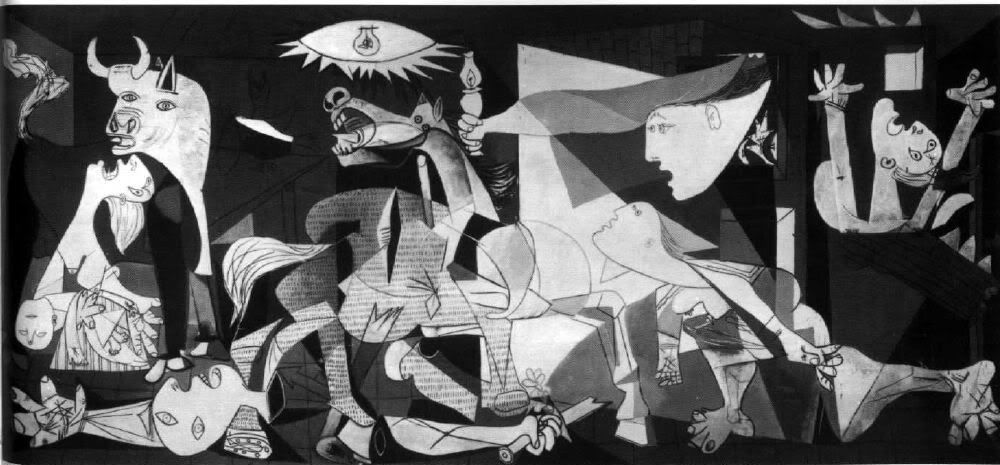
The artistic style that conveys and reflects the rhetorical appeal of logos is cubism. Cubism was explored and invented by Picasso in the early 20th century and depicts an alteration of perspectives: three dimensional viewpoints isolated, analyzed, and painted onto a two dimensional surface. It can also be defined as: “objects are broken up, analyzed, and re-assembled in an abstracted form…” The formulation of a new and innovative perspective achieved through a collage of old, manipulated perspectives characterizes cubism. This establishes an important aspect of cubism: the end of ambiguity. Art historian Ernst Gombrich described cubism as "the most radical attempt to stamp out ambiguity and to enforce one reading of the picture - that of a man-made construction…” A message or statement is clearly and best understood when one perspective is conveyed. This was one of Picasso’s primary goals in his painting Guernica. Picasso clearly reasons with his audience, through the presentation of perspective, that war is painful and full of suffering. He utilizes the rhetorical appeal of logos via illustration to establish a rational argument: that of anti-war. Picasso explains his perception and successful isolation of argument in his painting: “In the panel on which I am working, which I shall call Guernica, and in all my recent works of art, I clearly express my abhorrence of the military caste which has sunk Spain in an ocean of pain and death.”
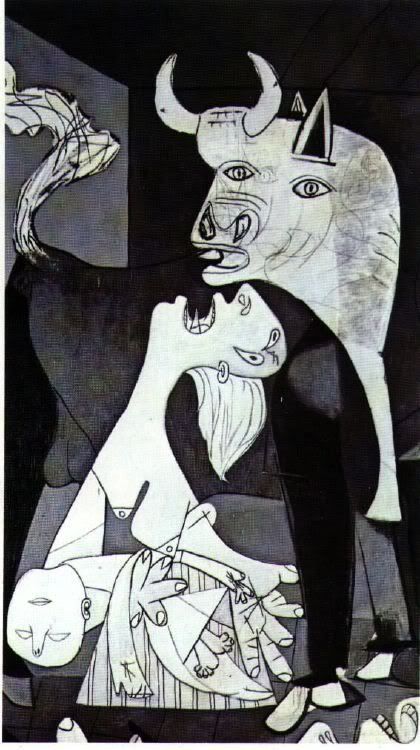
The figures in Picasso’s painting are clearly seen in pain, near death, or already dead. His use of illustration powerfully establishes his anti-war argument. The characters in the painting are contorted in agony. The woman on the far left of the painting is holding her dead child twisting her head back, weeping and mourning her loss. The horse in the center of the painting is twisted and tangled in pain as it is being pierced in the side by a spear. The curvy figures are intersected by sharp dark lines while the background and foreground overlap creating a sense of chaos and confusion. The woman on the far left disappears into the dark background—burning alive in a building. Only the head and upper appendages of fallen warrior can be detected in the painting as the rest of his body is enveloped in darkness. The bull is also swallowed into the dark background. These characters, in cubistic form, present one perspective, as well as an appeal to reason (anti-war) through the use of the rhetorical strategy illustration to establish the rhetorical appeal of logos.
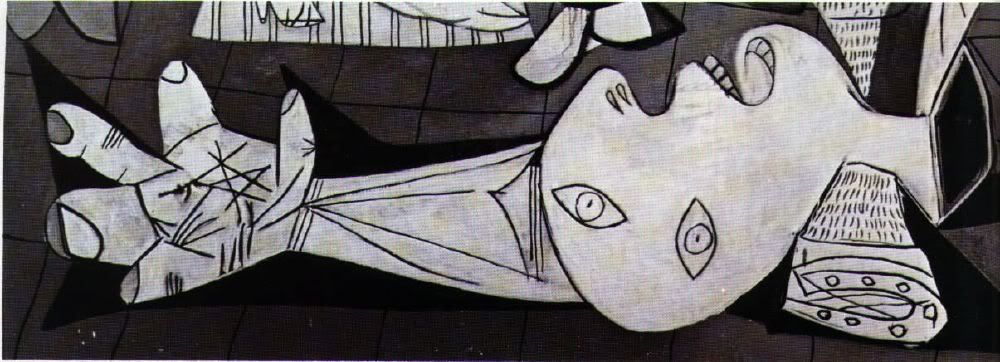
Logical fallacies are also at work in the painting. Guernica was painted during the Spanish Civil War in the late 1930’s (fascism takeover of a peaceful republic). Picasso was asked to present a painting at the National Exposition in Paris for the world fair. Picasso lacked inspiration for the painting until he saw a photo in the newspaper of the Nazi bombing of Guernica in Spain. Outraged at the violence in his native country, he began the painting. The painting clearly depicts war—specifically the side of war involving mass destruction, loss, and suffering—and reduces the argument to an extreme: the logical fallacy of the either-or argument. Only one side, one perspective, is depicted in the painting. This painting later became one of the most famous anti-war sentiments and propaganda icons of all time.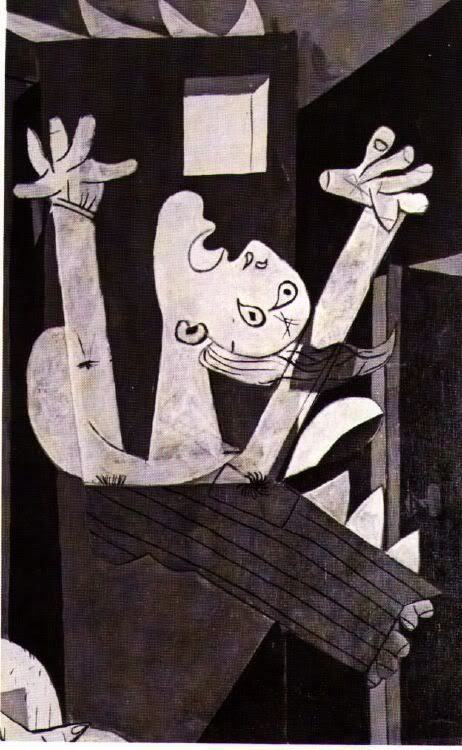 Picasso’s powerful and moving icon, Guernica, incorporates another artistic style: futurism. Futurism is close in technique and style to cubism, but subject matter greatly differs. Cubism subject matter appeals to still life objects and buildings; futurism subject matter commonly depicts modern urban scenes. Popular scenes include war and violence. “Futurism had from the outset admired violence and was intensely patriotic.” Picasso’s subject matter in Guernica directly agrees with the ideas of futurism. The setting of the painting is war and extreme violence as well as demonstrates Picasso’s loyalty to Spain and his personal stance against fascism. The use of the artistic style and subject matter, futurism, leads towards another rhetorical appeal, that of pathos.
Picasso’s powerful and moving icon, Guernica, incorporates another artistic style: futurism. Futurism is close in technique and style to cubism, but subject matter greatly differs. Cubism subject matter appeals to still life objects and buildings; futurism subject matter commonly depicts modern urban scenes. Popular scenes include war and violence. “Futurism had from the outset admired violence and was intensely patriotic.” Picasso’s subject matter in Guernica directly agrees with the ideas of futurism. The setting of the painting is war and extreme violence as well as demonstrates Picasso’s loyalty to Spain and his personal stance against fascism. The use of the artistic style and subject matter, futurism, leads towards another rhetorical appeal, that of pathos.
The subject matter of war overwhelmingly appeals to pathos. War is a time of misery, grief, disorder, and chaos. It has an extremely strong connection to emotion: “The work attempts to convey feelings and sensations experienced in time, using new means of expression, including ‘lines of force’, which were intended to convey the directional tendencies of objects through space, ‘simultaneity’, which combined memories, present impressions and anticipation of future events, and ‘emotional ambience’ in which the artist seeks by intuition to link sympathies between the exterior scene and interior emotion.” Guernica successfully directs emotions, sympathies, and expression from the canvas to its audience utilizing the rhetorical strategy of analogy, as well as symbolism, to support the strong rhetorical appeal to pathos.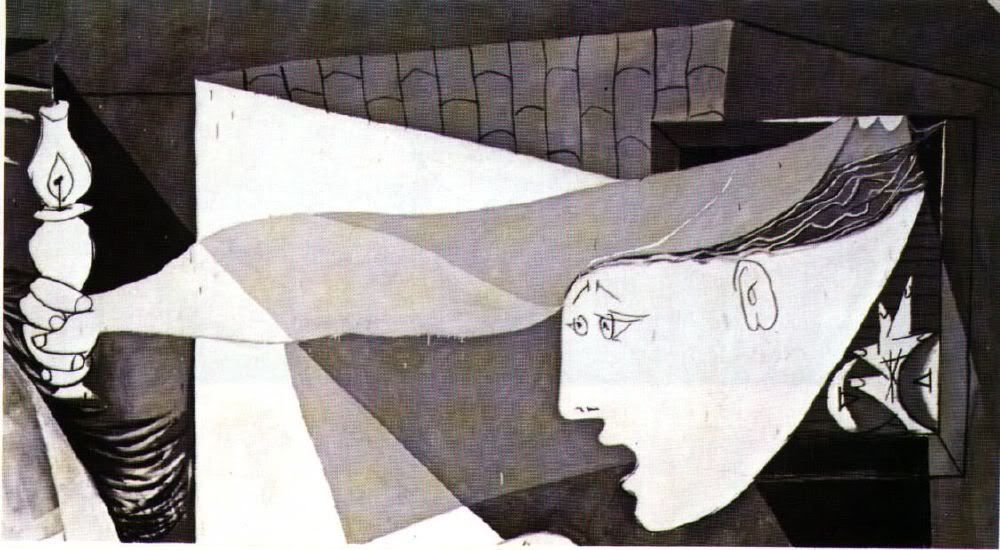
Picasso's Guernica is extremely symbolic. The use of symbolism supports analogy as well as the appeal to pathos, expressing an overwhelming amount of emotions. The painting is an open, dark, isolated area that gives rise to crowded pale figures portraying moments of loss, suffering, and chaos. The figure on the far left is a woman is engulfed in flames, most likely burning in a building—a possible scenario after the intense bombing of the city. (Guernica was said to have burned for three days after the bombings.) Below her is a fleeing woman. She looks towards the light in the top center of the paining as if to look for hope and relief from darkness. There is another woman in the painting holding a lantern. She also provides light for this scene, creating awareness and attention for the viewer as to what is happening in this scene. In the center of the  painting is a horse. Its face is in shock and agony as its side is pierced by a spear. The horse’s upper teeth and nose form to look like a human skull, an illustration of death and destruction. Underneath a horse is a fallen warrior. The warrior’s body is in pieces. His severed arm is clutching a shattered sword and flower. The flower is a representation of hope and ultimately new life and growth. The bull, an icon of Spain, is partially engulfed into the dark background. This parallels the attempt of fascist takeover of the republican government and the disappearance of a peaceful Spain. The story continues with a woman morning the loss of her child. This is one of the most powerful images in the painting. Her contorted body positions itself in agony and ultimate loss. Her head is back and she is screaming, wailing, and suffering. The child in her arms is lifeless, its eyes are shut and its body dangles in its mother’s arms.
painting is a horse. Its face is in shock and agony as its side is pierced by a spear. The horse’s upper teeth and nose form to look like a human skull, an illustration of death and destruction. Underneath a horse is a fallen warrior. The warrior’s body is in pieces. His severed arm is clutching a shattered sword and flower. The flower is a representation of hope and ultimately new life and growth. The bull, an icon of Spain, is partially engulfed into the dark background. This parallels the attempt of fascist takeover of the republican government and the disappearance of a peaceful Spain. The story continues with a woman morning the loss of her child. This is one of the most powerful images in the painting. Her contorted body positions itself in agony and ultimate loss. Her head is back and she is screaming, wailing, and suffering. The child in her arms is lifeless, its eyes are shut and its body dangles in its mother’s arms. There are also several analogies present in Picasso’s painting that portray raw and powerful emotions. Pain, suffering, and chaos are evident emotions depicted in the painting, but there are fiercer and greater emotions present that build an ultimate sentiment—that of dehumanization. War is dehumanizing and degrading and it is cleverly represented in Guernica. The breakdown of human character is exposed through the contortion and twisting of the figure’s bodies, the presence of animals among the humans, and the monochromatic color scheme. The lack of figuration and form of the characters contorts the figures to such an extreme that they are nearly unrecognizable as humans. Their bodies look as if they are being tortured, ripped apart, and openly exposed—creating emotions of horror and intense agony. The presence of animals, the horse and the bull, in the painting is analogous to animal behavior in humans. In a time of war, survival and out performance of the enemy are essential, most times reducing humans to instinctive and innate behavior, appealing to the emotions of disgust and repulsion. Lastly, the lack of color in the painting is also analogous to the reduction of humanity. The black and while color scheme degrades and reduces the figures to their most basic form. It strips them of their character and personality, their color, to the point where the figures are not seen as human, but a composition of lines and shapes. The convention of war and dehumanization is strongly and powerfully presented in Picasso’s painting. It successfully uses the rhetorical strategy of analogy to support its appeal to pathos.
There are also several analogies present in Picasso’s painting that portray raw and powerful emotions. Pain, suffering, and chaos are evident emotions depicted in the painting, but there are fiercer and greater emotions present that build an ultimate sentiment—that of dehumanization. War is dehumanizing and degrading and it is cleverly represented in Guernica. The breakdown of human character is exposed through the contortion and twisting of the figure’s bodies, the presence of animals among the humans, and the monochromatic color scheme. The lack of figuration and form of the characters contorts the figures to such an extreme that they are nearly unrecognizable as humans. Their bodies look as if they are being tortured, ripped apart, and openly exposed—creating emotions of horror and intense agony. The presence of animals, the horse and the bull, in the painting is analogous to animal behavior in humans. In a time of war, survival and out performance of the enemy are essential, most times reducing humans to instinctive and innate behavior, appealing to the emotions of disgust and repulsion. Lastly, the lack of color in the painting is also analogous to the reduction of humanity. The black and while color scheme degrades and reduces the figures to their most basic form. It strips them of their character and personality, their color, to the point where the figures are not seen as human, but a composition of lines and shapes. The convention of war and dehumanization is strongly and powerfully presented in Picasso’s painting. It successfully uses the rhetorical strategy of analogy to support its appeal to pathos.

Overall, Picasso’s union of different artistic styles, cubism and futurism, in the painting Guernica, conceives an image of powerful appeal and perspective. When filtered through a rhetorical lens it uses strategies of illustration and analogy to support is rhetorical appeals to logos and especially pathos. To this day, Guernica, a portrayal of suffering, conflict, and sentiment, is one of the most influential and compelling paintings of modern art.
Works Cited:
"Cubism." Wikipedia. 2008. 7 Apr 2008 http://en.wikipedia.org/wiki/Cubism.
"Futurism." Wikipedia. 2008. 7 Apr 2008 http://en.wikipedia.org/wiki/Futurism.
Moffat, Charles. "Cubism." Art History Archive-Art Movements 07 Apr 2008 http://www.arthistoryarchive.com/arthistory/cubism/.
"The Meaning of Cubsim." Cubism FAQ 04 Apr 2008 http://web-facstaff.sas.upenn.edu/~jenglish/Courses/Spring02/104/cubismFAQ.html.
"Guernica: Testimonies of War." Treasures of the World: Guernica 05 Apr 2008 http://www.pbs.org/treasuresoftheworld/a_nav/guernica_nav/main_guerfrm.html.
Hart, David. "PABLO PICASSO (1881-1973): FROM THE SPANISH CIVIL WAR TO VIETNAM ." Picasso's War Art 29 Jan 2004 04 Apr 2008 http://homepage.mac.com/dmhart/WarArt/StudyGuides/Picasso.html.
1 comment:
Cubism and protocubism are my favorite Pablo Picasso periods! I think that like the artist himself these styles of painting are defined by their internal contradictions!
Picasso certainly was a man of deep contradictions Picasso was a self avowed communist, however, Picasso was also one of the world's wealthiest artists, leaving his heirs an estate valued at $260 million ($1.5 billion in 2008 dollars) when he died in 1973. Pablo Picasso once remarked, 'I like to live like a poor man, except with lots of money'.
Site with good collection of Pablo Picasso protocubism, cubism and rose period paintings
Post a Comment